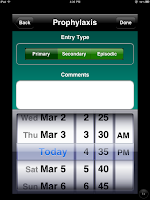Fast forward to 2010...MobileDataForce was asked to make an iPhone version of the application because many of the patients had started carrying iPhone's as their device of choice. This presented an issue, because at that time PointSync did not support synchronization and management tasks for anything but Windows Mobile devices.
To solve this, MDF engineers decided to build a sync tool from scratch, using Web Services to synchronize patient events from the iPhone to the database in the cloud. They started out by building the solution with very basic requirements, which consisted of only data synchronization. At completion of this first phase, they were 400 hours and $25,000 into it.
As patients began using it, it became evident that some critical pieces of the solution were missing. For example, when a sync issue came up, there were no auditing or troubleshooting tools to help support staff diagnose and resolve the problem. MDF engineers went back to the drawing board and added basic troubleshooting to the solution, causing the overall cost to rise far beyond the original expectations. In the end, only 10% of the functionality found in PointSync was incorporated into this custom sync solution.
With over 500,000 lines of code and a strong history since 2005, PointSync Pro 2.5 (and higher) now supports iPhone devices. In fact, we now support iPhone, Android AND BlackBerry devices. If you're considering building your own sync technology for your mobile enterprise solution, carefully consider everything it should do. Your list should include:
- Data synchronization and application/file deployment
- Cross-platform support for iPhone, Android, BlackBerry and Windows Mobile
- Support for end-to-end data encryption
- Allow mobile workers to work in a disconnected mode when connectivity is unavailable
- Logging and auditing to help diagnose and resolve technical issues
- Robust integration to databases (SQL Server, MySQL, DB2, SQL Anywhere) and third party systems
- An administrative interface to manage the entire system
At the end of the day, our experience has proven that there's no reason to re-invent this wheel. PointSync is ready to bolt into your environment right now to provide these necessary functions. If you need assistance building your mobile application as well, we can help with that too.
For more information on PointSync, please contact our sales team at (208) 384-1200 or visit the MobileDataForce website at www.mobiledataforce.com or the PointSync website at www.pointsync.com.





